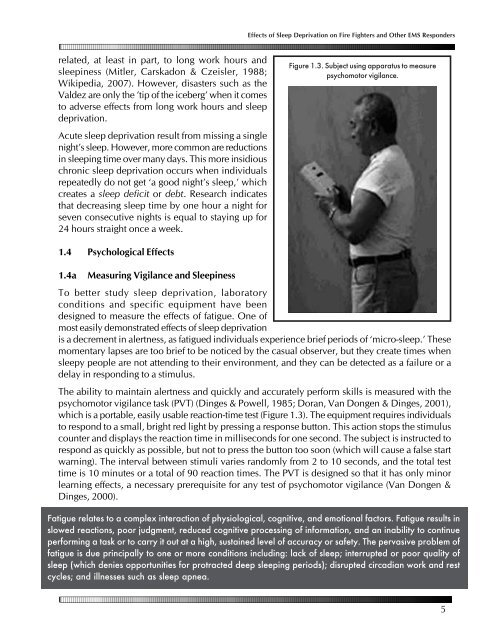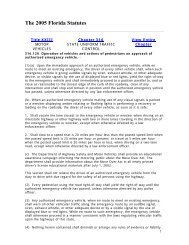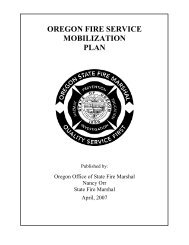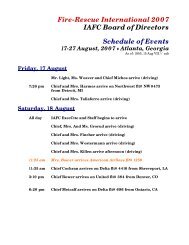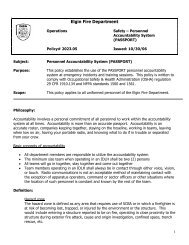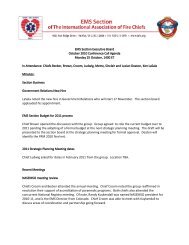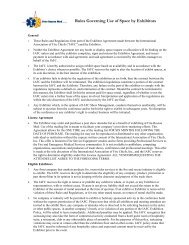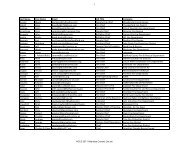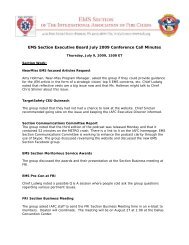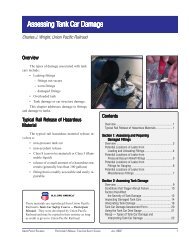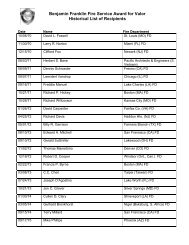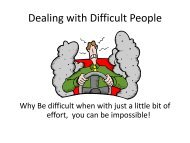Effects of Sleep Deprivation on Fire Fighters and EMS ... - NAEMT
Effects of Sleep Deprivation on Fire Fighters and EMS ... - NAEMT
Effects of Sleep Deprivation on Fire Fighters and EMS ... - NAEMT
Create successful ePaper yourself
Turn your PDF publications into a flip-book with our unique Google optimized e-Paper software.
<str<strong>on</strong>g>Effects</str<strong>on</strong>g> <str<strong>on</strong>g>of</str<strong>on</strong>g> <str<strong>on</strong>g>Sleep</str<strong>on</strong>g> <str<strong>on</strong>g>Deprivati<strong>on</strong></str<strong>on</strong>g> <strong>on</strong> <strong>Fire</strong> <strong>Fighters</strong> <strong>and</strong> Other <strong>EMS</strong> Resp<strong>on</strong>ders<br />
related, at least in part, to l<strong>on</strong>g work hours <strong>and</strong><br />
sleepiness (Mitler, Carskad<strong>on</strong> & Czeisler, 1988;<br />
Wikipedia, 2007). However, disasters such as the<br />
Valdez are <strong>on</strong>ly the ’tip <str<strong>on</strong>g>of</str<strong>on</strong>g> the iceberg’ when it comes<br />
to adverse effects from l<strong>on</strong>g work hours <strong>and</strong> sleep<br />
deprivati<strong>on</strong>.<br />
Acute sleep deprivati<strong>on</strong> result from missing a single<br />
night’s sleep. However, more comm<strong>on</strong> are reducti<strong>on</strong>s<br />
in sleeping time over many days. This more insidious<br />
chr<strong>on</strong>ic sleep deprivati<strong>on</strong> occurs when individuals<br />
repeatedly do not get ‘a good night’s sleep,’ which<br />
creates a sleep deficit or debt. Research indicates<br />
that decreasing sleep time by <strong>on</strong>e hour a night for<br />
seven c<strong>on</strong>secutive nights is equal to staying up for<br />
24 hours straight <strong>on</strong>ce a week.<br />
Figure 1.3. Subject using apparatus to measure<br />
psychomotor vigilance.<br />
1.4 Psychological <str<strong>on</strong>g>Effects</str<strong>on</strong>g><br />
1.4a Measuring Vigilance <strong>and</strong> <str<strong>on</strong>g>Sleep</str<strong>on</strong>g>iness<br />
To better study sleep deprivati<strong>on</strong>, laboratory<br />
c<strong>on</strong>diti<strong>on</strong>s <strong>and</strong> specific equipment have been<br />
designed to measure the effects <str<strong>on</strong>g>of</str<strong>on</strong>g> fatigue. One <str<strong>on</strong>g>of</str<strong>on</strong>g><br />
most easily dem<strong>on</strong>strated effects <str<strong>on</strong>g>of</str<strong>on</strong>g> sleep deprivati<strong>on</strong><br />
is a decrement in alertness, as fatigued individuals experience brief periods <str<strong>on</strong>g>of</str<strong>on</strong>g> ‘micro-sleep.’ These<br />
momentary lapses are too brief to be noticed by the casual observer, but they create times when<br />
sleepy people are not attending to their envir<strong>on</strong>ment, <strong>and</strong> they can be detected as a failure or a<br />
delay in resp<strong>on</strong>ding to a stimulus.<br />
The ability to maintain alertness <strong>and</strong> quickly <strong>and</strong> accurately perform skills is measured with the<br />
psychomotor vigilance task (PVT) (Dinges & Powell, 1985; Doran, Van D<strong>on</strong>gen & Dinges, 2001),<br />
which is a portable, easily usable reacti<strong>on</strong>-time test (Figure 1.3). The equipment requires individuals<br />
to resp<strong>on</strong>d to a small, bright red light by pressing a resp<strong>on</strong>se butt<strong>on</strong>. This acti<strong>on</strong> stops the stimulus<br />
counter <strong>and</strong> displays the reacti<strong>on</strong> time in millisec<strong>on</strong>ds for <strong>on</strong>e sec<strong>on</strong>d. The subject is instructed to<br />
resp<strong>on</strong>d as quickly as possible, but not to press the butt<strong>on</strong> too so<strong>on</strong> (which will cause a false start<br />
warning). The interval between stimuli varies r<strong>and</strong>omly from 2 to 10 sec<strong>on</strong>ds, <strong>and</strong> the total test<br />
time is 10 minutes or a total <str<strong>on</strong>g>of</str<strong>on</strong>g> 90 reacti<strong>on</strong> times. The PVT is designed so that it has <strong>on</strong>ly minor<br />
learning effects, a necessary prerequisite for any test <str<strong>on</strong>g>of</str<strong>on</strong>g> psychomotor vigilance (Van D<strong>on</strong>gen &<br />
Dinges, 2000).<br />
Fatigue relates to a complex interacti<strong>on</strong> <str<strong>on</strong>g>of</str<strong>on</strong>g> physiological, cognitive, <strong>and</strong> emoti<strong>on</strong>al factors. Fatigue results in<br />
slowed reacti<strong>on</strong>s, poor judgment, reduced cognitive processing <str<strong>on</strong>g>of</str<strong>on</strong>g> informati<strong>on</strong>, <strong>and</strong> an inability to c<strong>on</strong>tinue<br />
performing a task or to carry it out at a high, sustained level <str<strong>on</strong>g>of</str<strong>on</strong>g> accuracy or safety. The pervasive problem <str<strong>on</strong>g>of</str<strong>on</strong>g><br />
fatigue is due principally to <strong>on</strong>e or more c<strong>on</strong>diti<strong>on</strong>s including: lack <str<strong>on</strong>g>of</str<strong>on</strong>g> sleep; interrupted or poor quality <str<strong>on</strong>g>of</str<strong>on</strong>g><br />
sleep (which denies opportunities for protracted deep sleeping periods); disrupted circadian work <strong>and</strong> rest<br />
cycles; <strong>and</strong> illnesses such as sleep apnea.<br />
5


